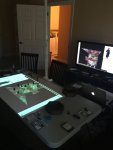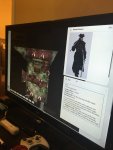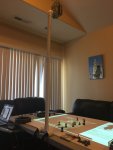I've been using roll20 F2F for a couple months now and it's been really well received.
Here's my setup and tips:
I hook my laptop up to an HDMI splitter that runs to the TV and to a short-throw projector I mount to the table (using some PVC piping and C-Clamps). I made the PVC pipe mount based off of a PVC camera mount instructible I found online, combined with another DM's mount plan that I saw. I wanted something I could clamp to the table and then take off when I'm done, or take with me so I can DM on the go. I'm not sure if I would have been able to get away with mounting a projector to the ceiling in my apartment.
When the players aren't in combat, I use the TV and display pictures of NPCs while the players speak with them, maps, locations, etc using the Roll20 handout functionality. I use my DM account on two windows, the player-facing one of them using the "Log In as Player" functionality so as to utilize dynamic lighting and hide my nefarious plans from player view.

Once combat kicks off, I turn on the projector as well and project the battlemap down onto the table. Players move their minis around on the grid and I update the tokens in Roll20 to match their positions. Much easier than having players try to describe which square they're moving to, plus it grants the fun of having custom-painted minis, etc. Plus, dynamic lighting. Oh man. So cool.
Speaking of which, I also use the projector for dungeon crawls.
Nothing was more magical than the first session when the players were exploring the Dragon Hatchery from HotDQ with dynamic lighting, not knowing what was around each corner, gradually exploring areas bit by bit, moving their minis across those 5ft squares.
Behind the scenes plotting
When combat broke out, it was easy for me to check which monsters were nearby (hidden away from player view) and send reinforcements at the proper movement speed, or have an NPC run away (again, at the proper movement speed) from battle to other parts of the dungeon to warn and alert people. It made for a much more immersive and exciting experience. It also made it really easy for me to do passive perception checks for the players and active checks for monsters/npcs/random encounters without alerting the PCs with the sound of rolling dice.
Combat Automation
I run all of the NPCs purely through Roll20 now, I load in all the combat stats, etc and use macros and token actions for attacks, spells, etc, updating hit points on the fly. It makes combat extra smooth, but it takes quite a bit of prep to set things up initially (setting up monster stats, creating tokens, etc).
If you're serious about doing this, I recommend plunking down the cash for a mentor subscription to Roll20 as it will allow you to use scripts that other people have written for the API, one of which lets you basically copy and paste monster statblocks straight out of the MM into Roll20 and it automatically creates a character with all the stats, actions, attacks, macros, etc to run that monster instantly. A major timesaver. With that script, I can probably load in a monster a minute if I needed to. Again, these aren't just statblocks, these are statblocks that come with buttons for each action that displays the attack roll, damage, effect, save DC, etc. SUPER convenient to have that all automatically created so quickly rather than typing it out by hand!
Turn Tracking
The initiative order is displayed right there on the page so there's no confusion or risk of anyone getting skipped. I can roll all the monster initiatives with a click of a button. I can throw down a random encounter with whatever creatures in my database onto one of hundreds of maps I have saved and be running that encounter within 30 seconds with zero prep beforehand. There's a handy turn counter functionality that you can use to keep track of spell durations, etc.
The biggest timesink at this point for me with it is mapmaking, which is a timesink in any setup. Fortunately a lot of great fantasy cartographers (Jared Blando, Mike Schley) make their maps available for download very inexpensively. I've also shelled out for PDF versions of all the Paizo Flipmats as well, converting them and loading them into Roll20 so I'm ready to run a lot of different encounters on the fly if I need to.
The Player Verdict?
My players
love it. Between this and Obsidian Portal, I get text messages from
all six players throughout the week telling me that they've been working on side stories and plots for their characters, asking me campaign questions, etc. It's incredible. They write adventure logs for me. I've never seen this level of player engagement before. Half of these people had never played D&D before and they want to bring their friends (I never thought my campaign would have a 6 person-deep "waitlist" before... but there you have it).
Easy Rule Lookup
The other thing I'm doing is making roll20 "handouts" for common rule bits (like spell descriptions, conditions, etc) thus if there's a question on how something works, I can just hit "/" on my keyboard (this sets the focus to the handout search field), type in "magic missile" or "petrified" or "underwater combat", and it'll pull up the handout. I click a button and it displays it on the TV to all the players. Much much much smoother than trying to search through a crappy OCR'd PHB and then moving the window to the TV for the players to see. It eliminates nearly all rule debates on-the-spot very quickly and shuts up quasi-know-it-alls with questionable interpretations of certain rules. It's especially fast to make these if you get your book scanned (I use 1dollarscan), since you can just take a screenshot of that portion of the rules and paste it right into the Roll20 handout. No need to try and correct OCR'd text or format things into an XML file or rely on third party scripts.
Is this encounter too deadly? One way to find out! Quick playtesting
I keep track of all the player stats in Roll20, which allows me to quickly playtest encounters when I'm aiming for something really tough but not unbeatable. It also allows me to very easily run
much more complicated encounters without slowing things down. For example:
I'm currently working on a boss fight that takes place in a sealed room with 9 platforms suspended 20 feet over a pool of water full of crocodiles. There are random environmental effects that kick in every turn (and I use Roll20's turn tracker to remind me to update them and the Roll20 virtual card deck that I draw a random card from that details the effect, I just plop that card on the VTT so everyone can see and remember, for example, that this turn there's a lot of wind in the room and ranged missile attacks are at disadvantage, or everything is icy, and to make a DC 10 acrobatics check at the start of the round or fall prone, etc ), 3 bridges randomly retract/extend between the platforms every round, changing the arena layout on a round-by-round basis and characters that remain stationary on a platform for longer than a turn have a 50% chance of triggering a fire trap one turn later (encouraging them to be mobile and not camp on a particular platform). There are animated suits of armor that come to life on specific rounds and 4 monsters caged around the arena that are randomly released each round.
(The boss has the ability to jump really far, a climb speed, and the mobility feat. In a straight up fight, he wouldn't last long, but with this environment, he's
very tough and it makes for a more interesting encounter.)
My point is: There is absolutely no way I would ever be able to run/keep-track-of/manage/remember everything for that encounter without reducing it to a glacial pace if I was running it without Roll20, or the players would be confused about which bridges were available or where they were. Or we might get tripped up having to look up underwater combat rules. Or I might make everything but find it too much of a pain to test it, resulting in a boss fight being way too easy or way too tough. But with Roll20, not only can I
run an encounter with so many different types of creatures and effects quickly, I can run it several times to playtest it before the party even shows up on Friday night, making tweaks to ensure that the experience is fun and balanced, yet challenging.
Where I stay physical
I still use paper handouts for things like player maps, letters, and print off cards for player spells and items since none of my players use Roll20 at the table, and it's still fun to find an excuse to print stuff off on parchment paper every now and then, right?

Plus, I find tangible "loot" in the form of item cards really gets players excited. Also, some of my players have physical character sheets that they use, and minis, dice, etc.
Looking back, I could have saved a
ton of money if I had just started with Roll20 + a new projector instead of shelling out tons of cash for physical maps, out-of-print dungeon tiles, etc...
Roll20 has completely revolutionized my D&D game, driven up player engagement, and allowed me to provide a much more exciting, dynamic, and living campaign than I was ever able to do before. Finally, although my setup was expensive initially, it is much much cheaper than physical maps, out-of-print dungeon tiles, printing off maps, ink costs, miniatures, etc.
(Although like I mentioned, I still use minis since nothing can match the look of fear when you throw down a large werewolf lord in front of a party at the end of a low-level dungeon. The intimidation factor makes it worth it)
Hope this helps.
EDIT: Sorry for the long post.... I just re-read and it sounds like I'm really bragging, that wasn't my intention--I've dedicated a significant amount of time to my setup though and I can personally vouch that Roll20 is an amazing tool for f2f D&D, but I could have saved a lot of time if I had known some things before I dove in.

I cannot recommend it enough if you're wanting to take your game to the next level and are willing to put in the time to set things up properly. Once you have it set up, it's very fast and convenient and so much better than thumbing through tons of books!













